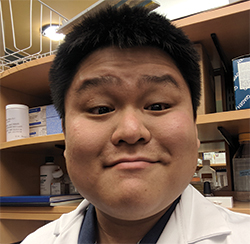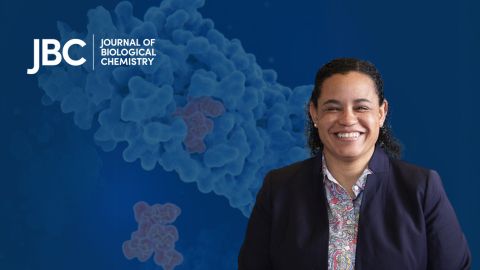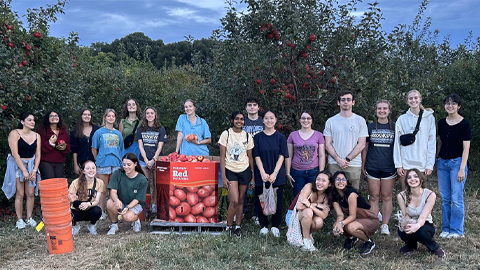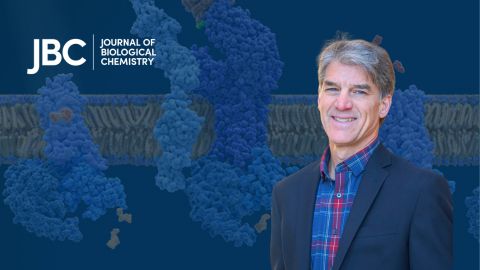HIV researcher wins Tabor award
Koree Ahn, a 3-D printing enthusiast, once brought two competing proposed structures of the HIV 1 envelope protein with him to a class discussion. “I was able to present these physical structures so that people could hold them and physically observe” the protein’s features, he recalled.
 Koree Ahn studied the interaction between coreceptor antagonists and fusion inhibitors in HIV infection. Courtesy of Koree Ahn
Koree Ahn studied the interaction between coreceptor antagonists and fusion inhibitors in HIV infection. Courtesy of Koree Ahn
The envelope protein allows the HIV membrane to fuse with a human cell’s. Ahn published a Journal of Biological Chemistry paper on drugs that block viral entry by inhibiting the envelope protein’s interaction with surface receptors. The work earned Ahn a 2018 JBC/Herbert Tabor Young Investigator Award.
Ahn laid a foundation for this kinetic and pharmacological research as a freshman at Hamline University in St. Paul, Minnesota. “What I originally thought would be a semester-long résumé builder instead became the four-year-long highlight of my undergraduate education,” Ahn said.
He worked with chemist Olaf Runquist to develop mathematical models of cell differentiation based on colon cancer samples from collaborator Bruce Boman, a professor at the University of Delaware. Over summers, he learned wet lab techniques in the Boman lab in Newark. He went on to graduate school at Thomas Jefferson University in Philadelphia.
“As a person who was from the Midwest, I fell in love with the diversity and the vibrancy of Philadelphia … and I was really interested in a lot of the research going on there,” he said of his decision to join the university’s program in biochemistry and molecular pharmacology.
Ahn’s doctoral project in Michael Root’s lab at Thomas Jefferson built on models of HIV entry established by colleagues. “All of the groundwork was really laid by previous members of the Root lab who had developed this super-quantitative model for how (HIV entry) inhibition works,” he said. He used the lab’s model and a library of entry inhibitors to untangle whether two classes of drugs exhibit synergy when used in combination. Reports in the literature had conflicted; as it turned out, so did results in the Root lab.
Ahn observed synergy that others in the lab had not, “and that led us to different questions, like, ‘What type of fusion inhibitors did you use? Did they bind very tightly to the fusion inhibitor binding site, or very loosely?’” Understanding these technical differences helped guide the team to the cohesive understanding of the factors permitting synergy that they published in JBC.
Ahn recently packed up his 3-D printer and moved to Chicago to continue his HIV research.
He now works as a postdoctoral fellow in the lab of Thomas Hope at Northwestern, studying interactions between HIV and molecules present in mucous membranes.
Complex interactions between HIV drugs
HIV enters human cells using an envelope protein that binds to two cell-surface receptors and then pulls the viral membrane near the cell membrane. Two drug classes block this process: coreceptor antagonists block interaction between the envelope protein and one receptor, and fusion inhibitors block membrane juxtaposition.
Because these two drugs act on steps in the same process, they might behave synergistically. Synergy between drugs occurs when the result of treatment with both together is more dramatic than would be expected by adding the two effects. But in fact, results of experiments testing for synergy were variable and confusing.
Koree Ahn and colleagues at Thomas Jefferson University in Philadelphia used a variety of molecules with slight differences to model a complex mechanism for interaction of the two drug classes. Ahn concluded that synergy between the drug classes is possible but dependent on two unexpected factors: the location and strength of fusion inhibitor binding to the envelope protein and the level of coreceptor expressed on the target cell.
The work, published in JBC in July, has clinical implications: It suggests that combining the two drug classes may not be an effective treatment strategy. For more on this work, see a companion article in JBC by Gregory Melikian of Emory University.
Enjoy reading ASBMB Today?
Become a member to receive the print edition four times a year and the digital edition monthly.
Learn moreGet the latest from ASBMB Today
Enter your email address, and we’ll send you a weekly email with recent articles, interviews and more.
Latest in People
People highlights or most popular articles

Meet Donita Brady
Donita Brady is an associate professor of cancer biology and an associate editor of the Journal of Biological Chemistry, who studies metalloallostery in cancer.

Glyco get-together exploring health and disease
Meet the co-chairs of the 2025 ASBMB meeting on O-GlcNAcylation to be held July 10–13, 2025, in Durham, North Carolina. Learn about the latest in the field and meet families affected by diseases associated with this pathway.

ASBMB recognizes 2025 outstanding student chapter
The Purdue group, led by Orla Hart, developed STEM outreach initiatives for low-income and minority students in Lafayette, Indiana.

ASBMB inducts 2025 honor society members
Chi Omega Lambda, which recognizes exceptional juniors and seniors pursuing degrees in the molecular life sciences, has 16 new inductees in 2025.

2025 voter guide
Learn about the candidates running for ASBMB President, Secretary, Councilor, Nominating Committee and Publications Committee.

Meet Paul Shapiro
Learn how the JBC associate editor went from milking cows on a dairy farm to analyzing kinases in the lab.

